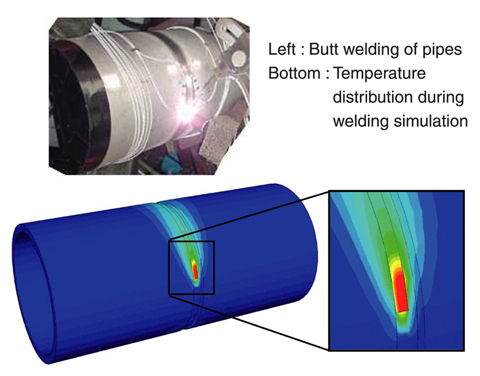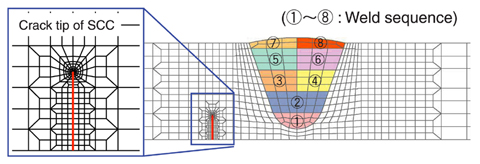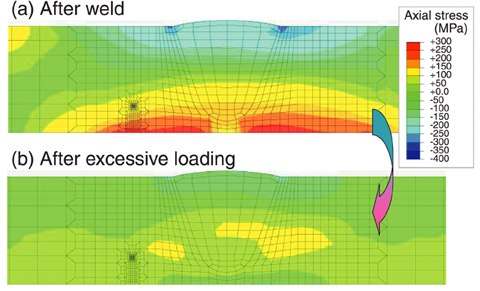
Fig.5-11 Overview of welding simulation

Fig.5-12 2D FEM model for welding simulation and SCC

Fig.5-13 Effect of earthquake on weld residual stress
The regulatory guide for reviewing seismic design was revised in September 2006 to redefine new range of envisioned earthquake ground motions and incorporate the concept of residual risks into the design framework, so as to reflect recent findings. Also, the July 2007 Niigata-ken Chuetsu-Oki earthquake ground motion exceeded the motion which were used in the design. Both of these events have made us aware of the need to assess the effect of large-scale earthquakes beyond the design basis of reactor components regarding seismic structural integrity. On the other hand, stress corrosion cracking (SCC) has been observed around the welds of reactor piping. Residual stress produced by welding is one of the most important factors influencing structural integrity, particularly SCC, because high tensile stresses at the inner surface and through the thickness around a pipe weld affect the initiation and growth behavior of SCC. It is, therefore, important that the structural integrity assessment take into account the effect of excessive loading, caused by a large-scale earthquake beyond the range envisioned in the design, on the weld residual stress in the pipe. However, the evaluation of residual stress distribution requires expertise and special skills for detailed weld simulation and experiments.
We have developed a welding simulation technique with excellent accuracy to evaluate the weld residual stress based on a finite element method (FEM) as shown in Fig.5-11. Using this simulation technique, weld residual stress around a butt weld for stainless steel piping was evaluated (Figs.5-12 and 5-13(a)). Since a large-scale earthquake may affect the weld residual stress distribution, the effect of excessive loading simulated by prescribed axial displacements on redistribution of the weld residual stress around piping weld was also evaluated as shown in Fig.5-13(b). From these results, it was clearly indicated that excessive loading caused residual stress relaxation, i.e. tensile stress at the inner surface of pipe decreased as applied seismic load increased. Similar relaxation behavior on residual stress was also observed in the case where there was an SCC near a weld. Therefore, there is a suppressive effect of large-scale earthquake on SCC growth and hence the evaluations of the structural integrity of reactor piping due to earthquakes are too conservative from the viewpoint of mechanical stress.
The effect of scattering of residual stress due to welding on structural integrity is now being investigated by application of a probabilistic fracture mechanics analysis method.